
Miles Joseph Berkeley was an English cryptogamist and clergyman, and one of the founders of the science of plant pathology. The standard author abbreviation Berk. is used to indicate this person as the author when citing a botanical name.
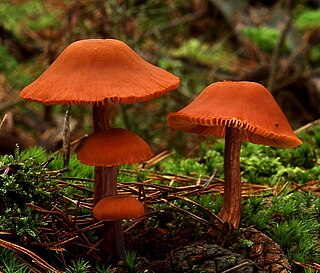
Laccaria laccata, commonly known as the deceiver, or waxy laccaria, is a white-spored species of small edible mushroom found throughout North America and Europe. It is a highly variable mushroom, and can look quite washed out, colorless and drab, but when younger it often assumes red, pinkish brown, and orange tones. The species is often considered by mushroom collectors to be a “mushroom weed” because of its abundance and plain stature.

Mordecai Cubitt Cooke was an English botanist and mycologist.
Christopher Edmund Broome was a British mycologist. The standard author abbreviation Broome is used to indicate this person as the author when citing a botanical name.

Science-Gossip was the common name for two series of monthly popular-science magazines, that were published from 1865 to 1893 and from 1894 to 1902. The first series was called Hardwicke's Science-Gossip, and the second series Science-Gossip.

Peniophora is a genus of fungi which are plant pathogens. Members of the genus belong to the class Agaricomycetes, order Russulales, and family Peniophoraceae. The genus is widespread, and contains 62 species. The species of Peniophora are resupinate, or crust-like, and are described as corticioid. A number of its members are parasitised by other fungi. For example, Tremella mesenterica is a parasite to several species of Peniophora.

Mycena vitilis, commonly known as the snapping bonnet, is a species of inedible mushroom in the family Mycenaceae. It is found in Europe and North America, where it grows on the ground among leaves in damp places, especially under alder. The small pale gray to whitish fruit bodies are usually attached to small sticks buried in the leaves and detritus. They are distinguished by their long, slender stems that root into the ground, and by the grooved cap that reaches diameters of up to 2.2 cm (0.9 in). The grayish-white gills on the underside of the cap are distantly spaced, and adnately attached to the stem. M. vitilis contains strobilurin B, a fungicidal compound with potential use in agriculture.
Pirex is a fungal genus in the family Meruliaceae. It is a monotypic genus, containing the single crust fungus Pirex concentricus. It is found in the Pacific Northwest region of North America, where it causes a white rot in woody hardwood and conifer debris generated by timber harvesting.
Grammothele is a genus of poroid crust fungi in the family Polyporaceae.

Fomes hemitephrus is a bracket fungus in the family Polyporaceae. First named Polyporus hemitephrus by English naturalist Miles Joseph Berkeley in 1855, it was given its current name by the English mycologist Mordecai Cubitt Cooke in 1885. The species is found in Australia and New Zealand, and is one of the most common polypores in those countries, causing a white rot on several tree species.

Anna Maria Hussey, née Reed was a British mycologist, writer, and illustrator.
The Woolhope Naturalists' Field Club is a society devoted to the natural history, geology, archaeology, and history of Herefordshire, England. Founded in 1851, it has had many notable members and played an important early role in the history of mycology in Britain.
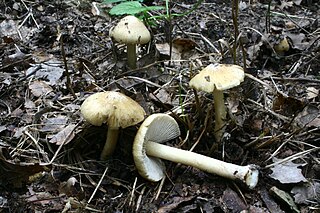
Inocybe cookei, commonly known as the straw fibrecap, is a species of mushroom in the family Inocybaceae. It was first described in 1892 by Giacomo Bresadola, and is named in honour of Mordecai Cubitt Cooke. The species is found in Europe, Asia and North America. It produces small mushrooms of an ochre colour, with a prominent umbo, fibres on the cap and a distinctive bulb at the base of the stem. It grows from soil in mixed woodland, and is encountered in summer and autumn, though is not common. Ecologically, it feeds through use of ectomycorrhiza. Inocybe cookei has been described as both toxic and non-toxic, but either way, is not advised for consumption.
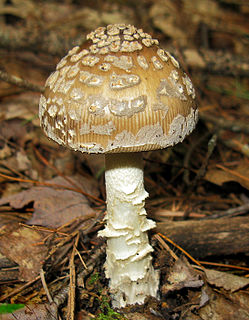
Amanita ceciliae, commonly called snakeskin grisette and strangulated amanita, is a basidiomycete fungus in the genus Amanita. First described in 1854 by Miles Joseph Berkeley and Christopher Edmund Broome, it was given its current name by Cornelis Bas in 1984. It is characterized by bearing a large fruit body with a brown cap 5–12 cm (2.0–4.7 in) across. The cap has charcoal-grey patches, which are easily removable. The stipe is 7–18 cm (2.8–7.1 in) long, white in colour, and there is no ring on it. It is slightly tapered to the top, and has irregular cottony bands girdling the base. The universal veil is grey. Spores are white, spherical in shape, non-amyloid, and measure 10.2–11.7 micrometres. The mushrooms are considered edible, but field guides typically advise caution in selecting them for consumption, due to risks of confusion with similar toxic species. A. ceciliae is found in woods throughout Europe and North America, where it fruits during summer and autumn.

Peniophora quercina is a species of wood-decay fungus in the family Peniophoraceae. It produces fruit bodies that vary in appearance depending on whether they are wet or dry. The wet fruit bodies are waxy and lilac, and attached strongly to the wood on which they grow. When dry, the edges curl up and reveal the dark underside, while the surface becomes crusty and pink. P. quercina is the type species of the genus Peniophora, with the species being reclassified as a member of the genus upon the latter's creation by Mordecai Cubitt Cooke. P. quercina is found primarily in Europe, where it can be encountered all year. Though primarily growing upon dead wood, especially oak, it is also capable of growing upon still-living wood.

Thelephora palmata is a species of clavarioid fungus in the family Thelephoraceae. The fruit bodies are leathery and coral-like, with branches that are narrow at the base before widening out like a fan and splitting into numerous flattened prongs. The wedge-like tips are whitish when young, but darken as the fungus matures. The common names of the fungus refers to its pungent odor, likened to fetid garlic. A widely distributed but uncommon species, it is found in Asia, Australia, Europe, North America, and South America, where it fruits on the ground in both coniferous and mixed forest.

Peziza domiciliana, commonly known as the domicile cup fungus, is a species of fungus in the genus Peziza, family Pezizaceae. Described by English mycologist Mordecai Cubitt Cooke, the fungus grows on rotten wood, drywall/plasterboard, and plaster in homes, damp cellars, and basements. It is known from Asia, Europe, North America, and Antarctica.
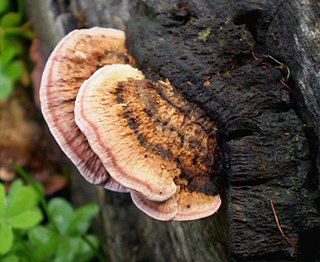
Rhodofomitopsis lilacinogilva is a species of bracket fungus in the family Fomitopsidaceae. Known primarily from Australia, it has also been recorded from Brazil and India. It is a white-rot fungus that grows on rotting eucalyptus wood. Its main identifying feature is the lilac colour of the pore surface on the underside of the fruit body.
Penicillium subtile is a species of fungus in the genus Penicillium.
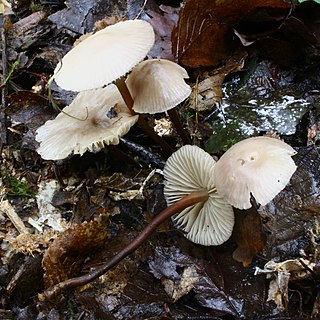
Marasmius wynneae is a species of gilled mushroom found in European woods.


















